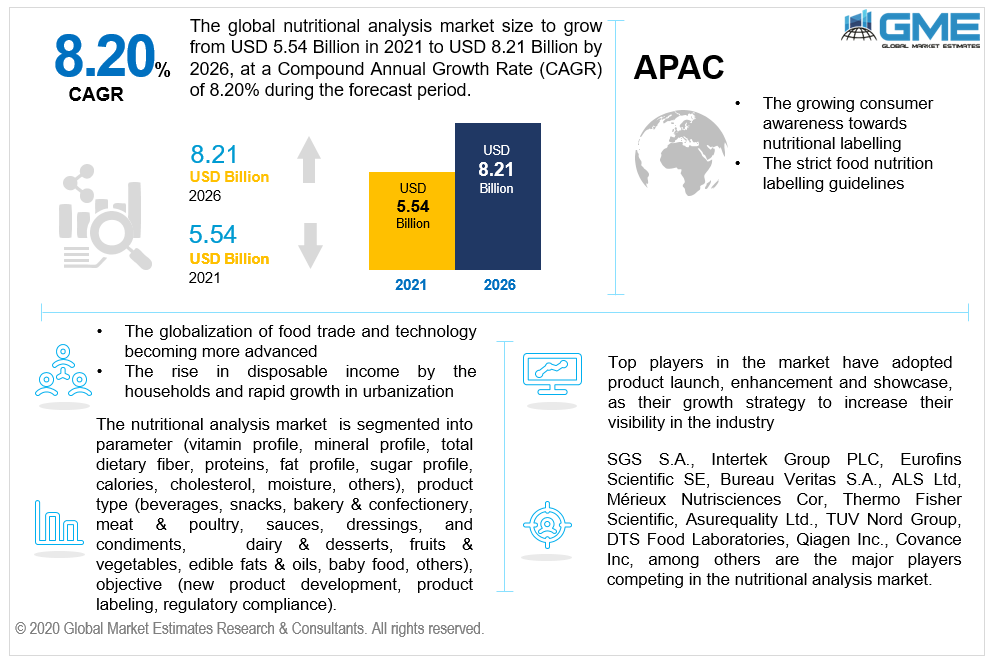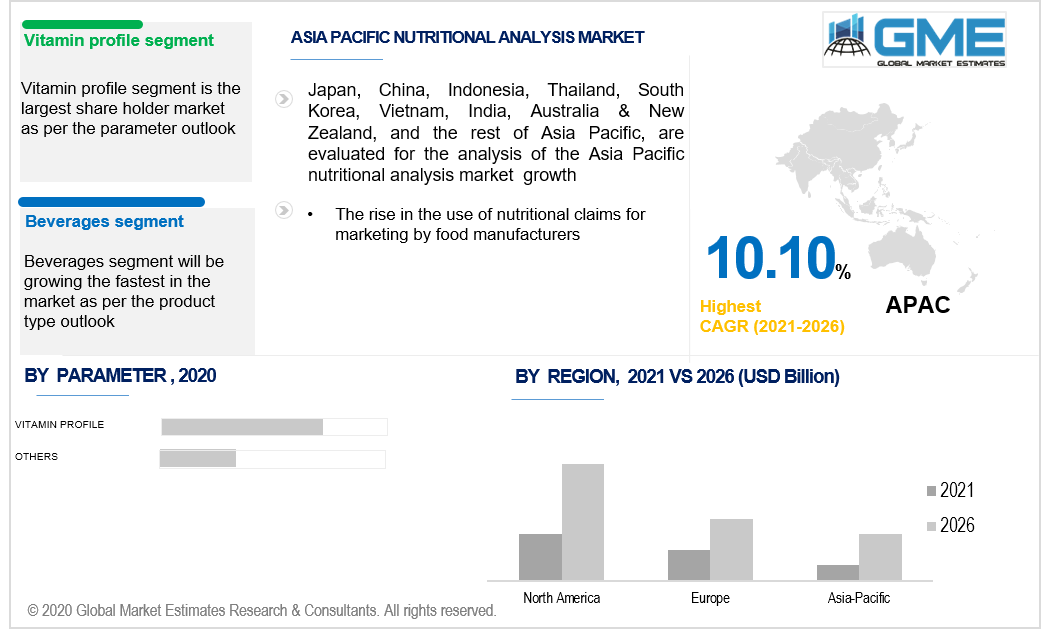
Global Nutritional Analysis Market Size, Trends, and Analysis - Forecasts To 2026 By Parameter (Vitamin profile, Mineral profile, Total dietary fiber, Proteins, Fat profile, Sugar profile, Calories, Cholesterol, Moisture, Others), By Product Type (Beverages, Snacks, Bakery & confectionery, Meat & poultry, Sauces, dressings, and condiments, Dairy & desserts, Fruits & vegetables, Edible fats & oils, Baby food, Others), By Objective (New product development, Product labeling, Regulatory compliance), By Region (North America, Asia Pacific, CSA, Europe, and the Middle East and Africa); End-User Landscape, Company Market Share Analysis & Competitor Analysis
The nutritional analysis market will generate huge revenue and continue the trend over the forecast period. Growing consumer awareness about the kind of food they are taking daily, frequently or occasionally is augmenting the market growth. With the deterioration of health conditions and rising diseases and deficiencies, it has become of utmost importance to monitor food habits. This will, in turn, affect the nutritional analysis market growth, positively.
The determination of the nutritional content of food, and providing a guide for the consumption of healthy food, is called nutritional analysis. It is a crucial part of analytical chemistry giving information on the chemical composition, quality control, processing, and contamination of food. Nutritional Analysis guarantees compliance with food and trade laws. In simplest terms, it is a way to improve food quality and ensure security. There are various certified methods used for performing nutritional analysis like chemical process and calculation method.
The laboratory analysis mainly involves food companies sending their food samples to laboratories for their physical examination. Applying scientific approaches and equipment, the food samples are analysed for the diverse components that constitute the nutritional information needed. The laboratory analysis determines the absolute levels of nutrients in the ready food, thus providing an adequate level of accuracy of the analysis. The analysis incorporates the changes in nutritional value that arise due to the cooking and processing of the food tested. This is of utmost importance as calories tend to increase or decrease during the process of cooking conditional to the method used. For instance, added fatty ingredients increase the calorie content during the frying process and lower during the grilling process. Moreover, when salt is added during the preparation of food, it upsurges the final sodium content of the dish. However, the food item samplings, food analysis, and interpretation of the results involve specialized expertise.
Nutritional analysis is applicable in the packaged retail food sector, via menu labeling and nutrition fact panels. To reduce informational asymmetry in the producer-consumer relationship, nutritional labeling plays an important role, with producers providing sufficient information that the consumers want to be aware of while consuming such products. This market for Nutritional Analysis has a vast number of market players, both emerging and giant players, owing to the enormous scope for opportunities because of developments in the market.
Nutritional Analysis has become essential due to consumers becoming more aware of the need for proper nutrition intake, growing incidence of sedentary diseases, rigorous nutritional labeling and food safety guidelines, globalization of food trade, and technology becoming more advanced. Other drivers are a rise in disposable income by the households and rapid growth in urbanization. The considerable level of malnutrition in low-income and developing countries also stimulates the need for efficient nutritional analysis of food products.

Based on the parameter analysis, the market is explained into ten different categories which include moisture, vitamin profile, cholesterol, mineral profile, calories, total dietary fiber, sugar profile, proteins, fat profile, and sugar profile among others.
Compared to the other segments, the category of vitamin profile will be the largest shareholder over the estimated time frame. The vitamin profile will be dominant due to the increase in demand for vitamin supplements, along with the population becoming more health-conscious. Additionally, due to the onset of Covid-19, the population has become more conscious and is now more inclined to consume more vitamin supplements frequently. This will enhance the immunity level in the individuals and also help to curb deficiencies of nutrients.
According to the product type analysis, the market is explained into beverages, dairy & dessert, snacks, bakery & confectionery, fruits & vegetables, meat & poultry, baby food, sauces, edible fats, edible oils, and dressings among others. The beverage segment will be the dominant segment and generate huge revenues compared to other products. The beverage segment's dominance can be attributed to the growing consumption of beverages in several forms, across the globe. The surge in consumption of beverages, ease of availability even virtually, and the development of several new products widening the range of options will be responsible for propelling this market’s growth.
Based on the objective study, the market is explained into three categories namely regulatory compliance, new product development, and product labelling. The product labelling segment will hold a major chunk in the global market and register a significant growth rate between 2021-2026. The changing policies of nutrition labelling across the globe, thus stimulating the manufacturers to abide by the regulations to be able to sell the products in the market, are major drivers for this market’s growth.

North America region will be a prominent part of the global market in terms of revenue and share, due to the growing consumer awareness towards nutritional labelling, strict food nutrition labelling guidelines, and rise in the use of nutritional claims for marketing by food manufacturers. In developing countries, the market share is relatively less due to lack of sophistication, organization, and required technology for the process of food nutrition testing, absence of expertise to execute regulations at a low level, and lack of coordination in the institutions.
SGS S.A. (Switzerland), Qiagen Inc. (U.S.), Covance Inc., Nutritional Information Solutions, Intertek Group PLC, nettnutrition, Eurofins Scientific SE (Luxembourg), NutriData, Bureau Veritas S.A. (France), MenuSano, ALS Ltd, Food Lab, Inc., AWTA Ltd, DTS Food Laboratories, Microbac Laboratories, Inc., TUV Nord Group, Mérieux Nutrisciences Cor, Asurequality Ltd, and Thermo Fisher Scientific among others, are top players sharing maximum revenue in the market.
Please note: This is not an exhaustive list of companies profiled in the report.
We value your investment and offer free customization with every report to fulfil your exact research needs.
The Global Nutritional Analysis Market has been studied from the year 2019 till 2026. However, the CAGR provided in the report is from the year 2021 to 2026. The research methodology involved three stages: Desk research, Primary research, and Analysis & Output from the entire research process.

The desk research involved a robust background study which meant referring to paid and unpaid databases to understand the market dynamics; mapping contracts from press releases; identifying the key players in the market, studying their product portfolio, competition level, annual reports/SEC filings & investor presentations; and learning the demand and supply-side analysis for the Nutritional Analysis Market.

The primary research activity included telephonic conversations with more than 50 tier 1 industry consultants, distributors, and end-use product manufacturers.

Finally, based on the above thorough research process, an in-depth analysis was carried out considering the following aspects: market attractiveness, current & future market trends, market share analysis, SWOT analysis of the company and customer analytics.

Tailor made solutions just for you
80% of our clients seek made-to-order reports. How do you want us to tailor yours?
OUR CLIENTS